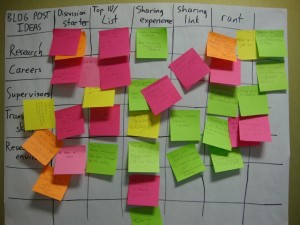I’ve had a little time off from working on my second book on the viva (coming soon!), and this has given me some time to check through my records. I’ve been a skills trainer since September 2008, and have accumulated a lot of stuff – some of it is worth keeping and refreshing myself on – some of it I’ve been happy to chuck into the recycling bin in the last few weeks.
I recently found my notes from a workshop that I ran for Vitae a couple of years ago. The session was on blogging and social media, but the idea that jumped back to the forefront for me was the icebreaker for the day’s workshop, which we used as a way to get people thinking of ideas for blog posts. The process is called Heuristic Ideation Technique:

This process for coming up with ideas is really simple, and you can read an expanded version here (yes, that is my image there too! The author of Gamestorming contacted me when I shared it a few years ago). Put simply, you create a table and for the titles of rows you put one area or way of looking at this, and for columns you focus on a different aspect.
So, in the example of the blogging workshop, we used areas where PGRs frequently look for advice as rows – Research, Careers, Supervisors, etc – and for columns we used different post styles – discussions starter, top ten, rant, and so on. After setting up the row and column headers, you can then use the intersections to come up with ideas. So the intersection of top ten and research might give the idea “Ten Things To Jumpstart Your Research” or “10 Questions To Ask Yourself At The Start Of Your PhD” or even “Ten Things That Suck About Research (And How To Fix Them)”.
The intersection of rows and columns is a boost to idea generation – the mind looks for patterns in everything, and the pattern forming generates ideas in this case. I love it as a technique, and am surprised that it dropped of my mental radar. I’ll be using it a lot in the coming weeks, both for posts on here, new writing projects and new ideas for other exciting things.
How might you apply this to what you do?
Thanks for reading!
Nathan (@DrRyder and @VivaSurvivors)
